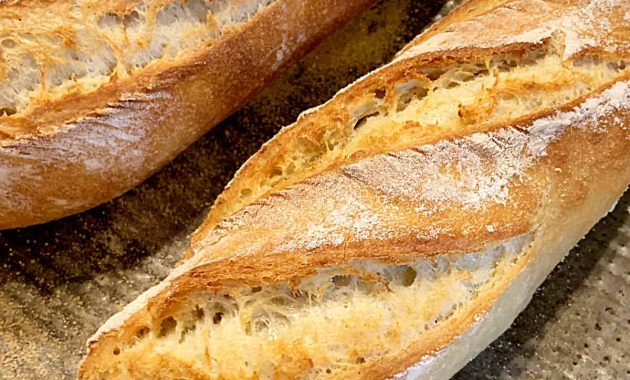About french bread
About french bread
Is there anything in the world that could compare with its taste – fresh, with a golden crust and a sweet crumb that melts in your mouth; able to saturate and deliver true pleasure?
I love bread! Salty, sweet, with spices, seeds, stale in the form of crackers, puff in the form of croissants and pies … The only exciting moment (forgive me all the nutritionists of our time combined!) Is the way it is prepared. I love “proper” bread.
This love led to the fact that I soon learned to bake myself – in my kitchen, in addition to the electric oven, a multifunctional bread machine takes pride of place, and in the corner the mother’s yeast-free sourdough is ripening (or, as the Italians call it, “pasta madre”, and the French “pâte au levain”). And the most cherished dream for me is a wood-burning stove. Indeed, despite all the miracles of technology, there is nothing better than bread baked on a live fire …
Wherever I happen to be, out of habit, on the first day I try to try local bread delicacies. I remember the first morning in Paris, when in the twilight of the rain I literally walked towards the smell – the smell of fresh bread from the bakery, confusing the words “baton” and “baguette” out of embarrassment … It’s good that the baker understood the foreigner at a half-word and with a smile handed me a crispy, golden color, the cherished “stick”!
Without a doubt, France is a country with the richest traditions, where the culture of bread has reached sky-high heights. True, recently authoritative publications have been writing about a reduction in the number of bakeries in France (in 1970 there were more than 45 thousand, and in 2015 – already 32 thousand), as well as a decrease in the daily portion of bread (in 1900, the average Frenchman ate 900 g per day, and in 2015 – only 120 g). But still, France is a grain country. According to research from the same 2015, 95% of the French still eat bread in various forms every day, considering it good for health and very important for a balanced diet.
One can argue for a long time, but one has only to imagine that back in the eighth (!) century, the French king Charlemagne ordered by decree: “The number of bakers must always be kept in full and their place of work must always be in order and clean.” Since then, the production and sale of bread has been regulated and controlled by the authorities.
Despite the control, the quality left much to be desired for a long time. What was not in the flour of medieval France – and bran, and tree bark, and acorn flour, and even algae in some parts of the country suffering from hunger. Many poor people were still very far from the luxury of eating real fresh bread in the morning …
In 1668, after the sensational success among the aristocracy of “pain-mollet” (that very white bread with a crumb), Louis XIV gathered 75 authoritative university professors in order to decide the fate of adding brewer’s yeast to bread, which at that time was considered an ingredient in some least doubtful … But long before that, Queen Marie de Medici had already enjoyed the delicacy that the court cook invented for her – soft bread containing milk, salt and brewer’s yeast. The Queen from Tuscany knew a lot about food (and not only), as you know!
Today we have the pleasure of enjoying the famous French baguette. With its beautiful caramel color, crispy crust and melt-in-your-mouth pulp, the baguette has become one of the emblems of France and Paris in particular. In addition, this culinary treasure is a small pleasure that we can afford for relatively little money.
True, the path of the favorite, now known to the whole world, was long and thorny. There are different versions of its origin. Someone claims that Gonesse bread (from the city of Gonesse in Val-d’Oase) became the ancestor of the baguette: already in the 15th century, Gonesse bread was very much in demand by Parisians, but until the 18th century it still remained round. And then someone came up with a brilliant idea to lengthen this shape. This option has always had significant advantages for bakers: bread baked faster and more crust formed.
Oh, how we appreciate this crust now!. I personally am ready to run for it to the other side of the Seine …
But back to the next versions. One of them is not really liked by the proud French, because if you believe it, the baguette was not invented at all by their compatriot … The Austrian August Zang (future publisher and Austrian politician) founded in 1839 a bakery specializing in Viennese bread in Paris – initially on pastries ( let’s leave the famous croissant alone for now!) It is said that it was Zang, inspired by the oval shape of the bread produced in his native country, that made a splash in Paris with his “long bread”.

Most amusing is the version of the creation of the baguette at the direction of Napoleon III. In 1856, the head of state set the weight and size of bread – 400 grams and 40 centimeters. But the round shape seemed completely unsuitable to him, because according to the plan, the bread had to be placed … in a long pocket of soldiers’ trousers (or be attached to the side, like a saber?) for greater ease of movement during the campaign. One can only imagine the “shape” of this baguette after a long forced march somewhere, for example, in distant Prussia…
And the last version is that the baguette was invented during the construction of the subway in Paris around 1900. In the underground passages there were frequent skirmishes between aggressive workers, sometimes it came to stabbing. To avoid cutting bread with knives, which could cause injury to workers, the construction project manager asked the bakers to create bread that could simply be broken by hand.
Be that as it may, since 1920 the baguette has overthrown the loaf of bread on French tables. Plus, the law for bakers “on night work” plays its role, according to which bakers themselves are interested in reducing the hours of making bread.
The French “stick” went through some more vicissitudes during the war, even almost losing its good reputation in the following years of the 20th century, but already in 1993, Decree 93-1074 of September 13 regulates the production of the “French tradition baguette” – this is a variety of elongated bread forms, the standard size of which is 55-65 cm, weight – 250-300 g and contains about 18 g of salt per 1 kg of flour. But, most importantly… this is a bread that will make you feel the ultimate pleasure with its crispy golden brown crust, “honeycombs” of creamy color (and nothing else!), and – oh, it’s just some kind of unearthly level! – taking the original form after pressing it … In truth, it is very difficult to bring such a treasure home safe and sound: firstly, when pressed hard, a hot baguette breaks right in your hands, and secondly, you simply eat it on the way!
If my reader has not yet run for a French baguette in the best bakery in his city, I, perhaps … will continue!
In order to further improve and encourage the work of bakers, since 1994, a competition for the best baguette of the capital has been organized in Paris. The jury members evaluate the famous “stick” according to certain criteria: appearance, baking quality, pulp, smell and taste. The winner is waiting for a prize of 4,000 euros, in addition, he becomes the official exclusive supplier of bread to the table of the President of France himself at the Elysee Palace. This lucky winner in 2018 and the winner of the main prize was a young 27-year-old baker of Tunisian origin Mahmoud M’seddi from a bakery in the 14th arrondissement of Paris.
No matter how much I praise the French baguette, there will definitely be those who want to refute all my arguments. And all because – yes, it’s true! – NOT ALL Parisian bread is of good quality and taste. Oh horror!..It arrives at some points already frozen and half ready! Unfortunately it is so. And I beg you, do not look for a real baguette in the nearest supermarket! Such a purchase will result, at least, in disappointment, if not pain in the stomach …
Is the difference noticeable?
Every self-respecting Parisian has his “own” baker. It is part of French culture, a tradition worthy of emulation. People have been buying their favorite bread from their favorite baker for years, paying tribute to his work and talent.
Having studied the bakeries and bakeries of the left bank of the Seine well, I often run for bread at “Le Moulin de la Vierge”, I admire the famous “La Maison Kayser”, I am inspired by the variety of quality products from “Max Poilâne”. But the greatest authority for me is Monsieur Pichard and his “La Maison Pichard”. Frederic Pichard is not just a baker, but a researcher and scientist. One has only to listen to him talk about the process of fermentation and baking bread! This is a real “philosophy of bread” .



